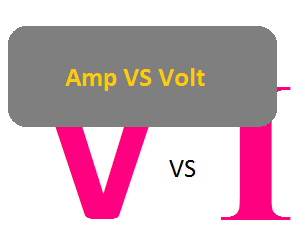Amp VS Volt | The Main Differences between Ampere and Volt
The main difference between Ampere(in short Amp) and Volt is ampere is the unit for the measuring of electric current whereas the Volt is the unit for the measuring of electric potential or voltage or electromotive force. So Ampere is the SI unit of current whereas Volt is the SI unit of Voltage. Amp and Volt can be differentiated based on other different factors also. So let's discuss about it.
What are Current and Amps or Ampere?
Current is the flow of electrical charge carriers such as electrons or electron-deficient atoms through a conductive path. It also can be referred to as a rate at which the electrical current flow. And ampere or Amp is the international unit to measure this flow of current. It is said that 1-ampere current means 1-coulomb electrons are moving in a circuit or pass a single point in one second. The unit of current or ampere also has several ranges such as Ampere(A) is a large unit, Milliampere(mA) is the thousandth of an Ampere(0.001), and the Microampere (µA) is the millionth of an Ampere(0.000001). The symbol of the ampere is generally denoted by the letter 'I'
The flow of current in a conductive path or any closed circuit depends upon the main two important factors such as electric potential or voltage and resistance. If there is no voltage means no current. The voltage or the potential difference creates the force to flow the electric current in a circuit. Also, remember that the direction of the current is opposite to the flow of electrons. Generally, the current flows from the higher potential to the lower potential.
What are Voltage and Volt?
Voltage is the pressure from the electrical power source that forces the electrons or charge to flow in the circuit. Volt is the international unit to measure the voltage. There are mainly two types of voltage mostly used for electrical and electronics applications that are - 1. Alternating Voltage or AC Voltage and 2. Direct Voltage or DC Voltage.
The DC voltage is constant in nature and polarity. That means a 9V DC source will provide a constant 9V voltage with the same polarity. But on the other hand, a 9V AC source will provide varying voltage with varying polarity. Voltage is sometimes dropped or decreased by the resistance of the circuit or any component. And this voltage drop depends upon the value of the resistance and the value of the current. In a series circuit, voltage is different across each component of that circuit whereas in a parallel circuit voltage is the same or equal across each component of the circuit.
Key Differences between Amp and Volt
1. Volt is measured in different forms such as Volt, Kilovolt, Mili Volt whereas the ampere is measured in different forms such as milliamperes, microampere, kiloampere, etc.
2. Volt is measured at any two points of a circuit whereas the ampere is measured at any single point of the circuit.
3. Volt is symbolized or denoted by English letter 'V' whereas the Ampere is symbolized or denoted by english letter 'I'.
4. Volt is measured by the voltmeter that is to be connected to the circuit in parallel whereas Ampere is measured by the ammeter that is to be connected to the circuit in parallel.
5. From the ohm's law volt can be calculated by multiplying resistance to the current whereas amp can be calculated by dividing the voltage by resistance.
6. Generally, the electrical power sources are rated with volt and wattage whereas electrical loads are rated with amp and wattage.
Read Also:

